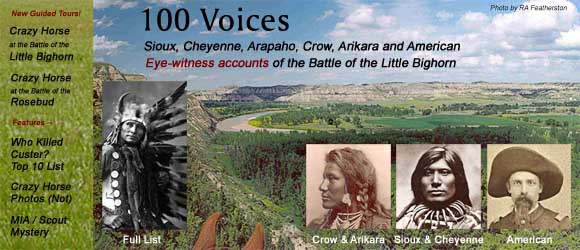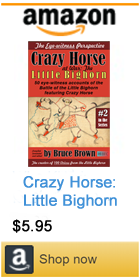Bruce Brown's 100 Voices... Rain In The Face's Story of the Battle #1
RAIN IN THE FACE'S ACCOUNT OF THE BATTLE OF THE LITTLE BIGHORN |
|||||||||
By Dr. Charles Eastman (Ohiyesa) The noted Sioux warrior, Rain-in-the-Face, whose name once carried terror to every part of the frontier, died at his home on the Standing Rock reserve in North Dakota on the 14th of October, 1905. About two months before his death I went to see him for the last time, where he lay upon the bed of sickness from which he never rose again, and drew from him his life history. It has been my experience that you cannot induce an Indian to tell a story, or even his own name, by asking him directly. "Friend," I said, "even if a man is on a hot trail, he stops for a smoke. In the good old days, before the charge there was a smoke. At home, by the fireside, when the old men were asked to tell their brave deeds, again the pipe was passed. So come, let us smoke now to the memory of the old days." He took of my tobacco and filled his long pipe, and we smoked. Then I told an old mirthful story to get him in the humor of relating his own history. The old man lay upon an iron bedstead, covered by a red blanket, in a corner of the little log cabin. He was all alone that day; only an old dog lay silent and watchful at his master's feet. Finally he looked up and said with a pleasant smile: "True, friend; it is the old custom to retrace one's trail before leaving it forever. I know that I am at the door of the spirit home. "I was born near the forks of the Cheyenne River, about seventy years ago. My father was not a chief; my grandfather was not a chief, but a good hunter and feastmaker. On my mother's side I had some noted ancestors, but they left me no chieftainship. I had to work for my reputation. "When I was a boy, I loved to fight," he continued. "In all our boyish games I had the name of being hard to handle, and I took much pride in the fact. "I was about ten years old when we encountered a band of Cheyennes. They were on friendly terms with us, but we boys always indulged in sham fights on such occasions, and this time I got in an honest fight with a Cheyenne boy older than I. I got the best of the boy, but he hit me hard in the face several times, and my face was all spattered with blood and streaked where the paint had been washed away. The Sioux boys whooped and yelled: "'His enemy is down, and his face is spattered as if with rain! Rain-in-the-Face! His name shall be Rain-in-the-Face!" "WHEN WE CROSSED from Tongue River to the Little Big Horn, on account of the scarcity of game, we did not anticipate any more trouble. Our runners had discovered that Crook had retraced his trail to Goose Creek, and we did not suppose that the white men would care to follow us farther into the rough country. "Suddenly the Long-Haired Chief appeared with his men! It was a surprise." "What part of the camp were you in when the soldiers attacked the lower end?" I asked. "I had been invited to a feast at one of the young men's lodges [a sort of club]. There was a certain warrior who was making preparations to go against the Crows, and I had decided to go also," he said. "While I was eating my meat we heard the war cry! We all rushed out, and saw a warrior riding at top speed from the lower camp, giving the warning as he came. Then we heard the reports of the soldiers' guns, which sounded differently from the guns fired by our people in battle. "I ran to my teepee and seized my gun, a bow, and a quiver full of arrows. I already had my stone war club, for you know we usually carry those by way of ornament. Just as I was about to set out to meet Reno, a body of soldiers appeared nearly opposite us, at the edge of a long line of cliffs across the river. "All of us who were mounted and ready immediately started down the stream toward the ford. There were Ogallalas, Minneconjous, Cheyennes, and some Unkpapas, and those around me seemed to be nearly all very young men.
"The woman was Tashenamani, or Moving Robe, whose brother had just been killed in the fight with Three Stars. Holding her brother's war staff over her head, and leaning forward upon her charger, she looked as pretty as a bird. Always when there is a woman in the charge, it causes the warriors to vie with one another in displaying their valor," he added. "The foremost warriors had almost surrounded the white men, and more were continually crossing the stream. The soldiers had dismounted, and were firing into the camp from the top of the cliff." "My friend, was Sitting Bull in this fight?" I inquired. "I did not see him there, but I learned afterward that he was among those who met Reno, and that was three or four of the white man's miles from Custer's position. Later he joined the attack upon Custer, but was not among the foremost. "When the troops were surrounded on two sides, with the river on the third, the order came to charge! There were many very young men, some of whom had only a war staff or a stone war club in hand, who plunged into the column, knocking the men over and stampeding their horses. [Note: these could have been the Cheyenne suicide warriors.] "The soldiers had mounted and started back, but when the onset came they dismounted again and separated into several divisions, facing different ways. They fired as fast as they could load their guns, while we used chiefly arrows and war clubs. There seemed to be two distinct movements among the Indians. One body moved continually in a circle, while the other rode directly into and through the troops. "Presently some of the soldiers remounted and fled along the ridge toward Reno's position; but they were followed by our warriors, like hundreds of blackbirds after a hawk. A larger body remained together at the upper end of a little ravine, and fought bravely until they were cut to pieces. I had always thought that white men were cowards, but I had a great respect for them after this day.
"After the first rush was over, coups were counted as usual on the bodies of the slain. You know four coups [or blows] can be counted on the body of an enemy, and whoever counts the first one [touches it for the first time] is entitled to the 'first feather.' "There was an Indian here called Appearing Elk, who died a short time ago. He was slightly wounded in the charge. He had some of the weapons of the Long-Haired Chief, and the Indians used to say jokingly after we came upon the reservation that Appearing Elk must have killed the Chief, because he had his sword! However, the scramble for plunder did not begin until all were dead. I do not think he killed Custer, and if he had, the time to claim the honor was immediately after the fight. "Many lies have been told of me. Some say that I killed the Chief, and others that I cut out the heart of his brother [Tom Custer], because he had caused me to be imprisoned. Why, in that fight the excitement was so great that we scarcely recognized our nearest friends! [Note: according to George Bird Grinnell, Little Horse killed Tom Custer.] "Everything was done like lightning. After the battle we young men were chasing horses all over the prairie, while the old men and women plundered the bodies; and if any mutilating was done, it was by the old men. "I have lived peaceably ever since we came upon the reservation. No one can say that Rain-in-the-Face has broken the rules of the Great Father. I fought for my people and my country. When we were conquered I remained silent, as a warrior should. Rain-in-the-Face was killed when he put down his weapons before the Great Father. His spirit was gone then; only his poor body lived on, but now it is almost ready to lie down for the last time. "Ho, hechetu! [It is well.]" "Rain-in-the-Face, the story of a Sioux warrior" by Charles Alexander Eastman, in: The Outlook, October 27, 1906, p. 507 - 512
The two primary accounts of the battle by Rain In The Face are very different, and frankly contradictory. The first (actually the second chronologically) by Santee Sioux Ohiyesa is sympathetic and respectful -- essentially a death bed conversation between two old friends -- while the second by American journalist W. Kent Thomas is glibly exploitive -- Thomas purportedly got Rain In The Face drunk to induce him to tell his tale. Yet both accounts sound like the same man talking, and they both have something to contribute, even if they contradict each other at many important turns. For instance, in the Ohiyesa version, Rain In The Face identified an Anonymous Youth (who was subsequently slain) as Custer's killer, while in the Thomas version, he said no one knew who killed Custer -- "it was like running in the dark." In the Thomas version, Rain In The Face said he cut out his old nemesis Tom Custer's heart and spit it in his face, while in the Ohiyesa version he denied the whole Tom Custer battlefield episode -- "many lies were told about me." Even so, the Battle of the Little Bighorn story most closely associated with Rain In The Face is probably still the famous poem by Henry Wadsworth Longfellow,"The Revenge of Rain-in-the-Face," which features Rain In The Face cutting out Tom Custer's heart in "revenge" for his abusive treatment of Rain In The Face at Ft. Lincoln the year before, witnessed by Frank Huston, who saw Tom Custer "kick and slap Rain while troopers held him." Historically speaking, Longfellow's poem is steeped in misconception. For starters, neither Custer nor his men were carrying sabers (as Rain In The Face correctly recalled in the W. Kent Thomas interview). More importantly, Seventh Cavalry surgeon Dr. H.R. Porter, who examined the corpses the day after the battle, said neither George nor Tom Custer's heart was not cut out (although Charles Roe, who was on the burial detail after the battle, disagreed). Furthermore, based on the eye-witness record, it appears that Oglala Sioux war chief Little Horse or Minneconjou Sioux warrior Lazy White Bull were more likely Tom Custer's killer. Nonetheless, Rain In The Face was a force at the Battle of the Little Bighorn. Ohiyesa said Rain In The Face was a leader of the Indians' first counter-charge against Reno, which forced the American troopers to abandon their defensive line in the open and fall back to the timber along the river. Thunder Bear called Rain In The Face the bravest man in the battle. Little Knife said the Rain In The Face was the only Indian who took a Seventh Cavalry prisoner during the battle. -- Bruce Brown
|
|||||||||





 "'Behold, there is among us a young woman!' I shouted. 'Let no young man hide behind her garment!' I knew that would make those young men brave.
"'Behold, there is among us a young woman!' I shouted. 'Let no young man hide behind her garment!' I knew that would make those young men brave.








